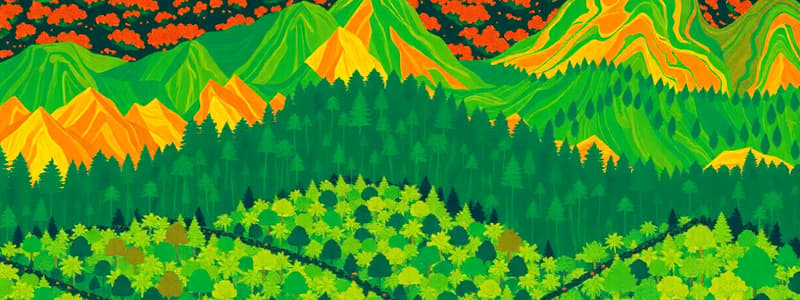Podcast
Questions and Answers
Which feature of Squirrel monkeys aids them in grasping branches?
Which feature of Squirrel monkeys aids them in grasping branches?
- Prehensile tail
- Rotating shoulders (correct)
- Camouflage tactics
- Pointy-tipped leaves
What is the primary source of nutrients for epiphytes like ferns?
What is the primary source of nutrients for epiphytes like ferns?
- Soil
- Animal waste
- Water and air (correct)
- Decomposers
Which animal is considered a high-trophic-level carnivore?
Which animal is considered a high-trophic-level carnivore?
- Boa constrictor
- Jaguar (correct)
- Tapir
- Agouti
What role do decomposers play in the ecosystem?
What role do decomposers play in the ecosystem?
Which of the following is a renewable resource mentioned?
Which of the following is a renewable resource mentioned?
What helps plants grow, alongside soil, according to the content provided?
What helps plants grow, alongside soil, according to the content provided?
Which statement is true regarding the relationship between plants and decomposers?
Which statement is true regarding the relationship between plants and decomposers?
What is one way humans use nonrenewable resources mentioned in the content?
What is one way humans use nonrenewable resources mentioned in the content?
What is the height range of emergent trees in a tropical rainforest?
What is the height range of emergent trees in a tropical rainforest?
Which geographical area is NOT associated with tropical rainforests?
Which geographical area is NOT associated with tropical rainforests?
Which layer of the tropical rainforest has the least amount of light?
Which layer of the tropical rainforest has the least amount of light?
What is the primary difference between the understory and the upper canopy layers?
What is the primary difference between the understory and the upper canopy layers?
What is the average annual rainfall in tropical rainforests?
What is the average annual rainfall in tropical rainforests?
Which of the following is an abiotic factor in tropical rainforests?
Which of the following is an abiotic factor in tropical rainforests?
What is the highest mountain in a tropical rainforest?
What is the highest mountain in a tropical rainforest?
Which of the following describes the climate in tropical rainforests?
Which of the following describes the climate in tropical rainforests?
Flashcards are hidden until you start studying
Study Notes
Tropical Rainforest Geographical Areas
- Tropical Rainforests are located around the equator in Central America, Africa, and Indo-Malaysia
- Amazon River basin located in Central America
- Zaire basin and a small area in West Africa, as well as eastern Madagascar are located in Africa
- West coast of India, Assam, Southeast Asia, New Guinea, and Queensland, Australia are located in Indo-Malaysia
Tropical Rainforest Layers
- Emergent Layer: 100 to 240 feet tall trees with umbrella shaped canopies that grow above the forest.
- Upper Canopy: 60 to 130 foot trees. Sunlight is available at the top, but significantly reduced below.
- Understory: 60 feet tall trees consisting of trunks of canopy trees, shrubs, plants, and small trees.
- Forest Floor: Usually completely shaded, except where a canopy tree has fallen. Very little light restricts plant growth.
Tropical Rainforest Landforms
- Mountains: The highest Tropical Rainforest mountain is Pica da Neblina, located in the Amazon Rainforest.
- Karst Landscapes: Tehuacan stone snakes (tecuates) found in North America, Mexico, Puebla, along several streets in Tehuacán, also in El Riego Park
- Rivers: The Amazon River in South America is the largest river by water volume and the second-longest river system in the world.
Tropical Rainforest Climate
- Rainfall: 2,000 to 10,000 millimeters (79 to 394 inches) of rain per year.
- Temperature: Mean temperatures range between 68 and 84 °F. Temperatures do not fall below 64 °F.
Tropical Rainforest Abiotic & Biotic Factors
- Abiotic: Soil composition, humidity, temperature, sunlight.
- Biotic:
- Buttress Roots: Large roots help support large trees.
- Ferns: Epiphytes that live on tree branches high in the canopy. They obtain nutrients from the air and water, not from soil.
- Maiden's Blush: Leaves with pointy tips to allow water to quickly run off and prevent damage.
Tropical Rainforest Food Web
- Producers: Green plants utilize sunlight, water, and soil for photosynthesis.
- Herbivores: Agouti and tapirs feed on these plants.
- Secondary Consumers: Boa constrictors consume herbivores for energy.
- High-trophic-level Carnivores: Jaguars, crocodiles, and birds of prey consume carnivores and omnivores.
- Decomposers and Scavengers: Bacteria, fungi, and toucans break down dead organisms and recycle nutrients into the ecosystem.
Tropical Rainforest Natural Resources
- Renewable Resources: Avocado, guava, trees (used for building & medicine), plants, animals, passion fruits, oils from trees.
- Nonrenewable Resources: Minerals like gold and copper, cattle, hydroelectric energy.
Human Impact on Tropical Rainforests
- Consuming Food: Avocado and guava are consumed.
- Building Materials: Trees used to construct houses and other buildings.
- Oil Extraction: Oil used for frying.
- Gold Mining: Used for fashion and other purposes.
Studying That Suits You
Use AI to generate personalized quizzes and flashcards to suit your learning preferences.




